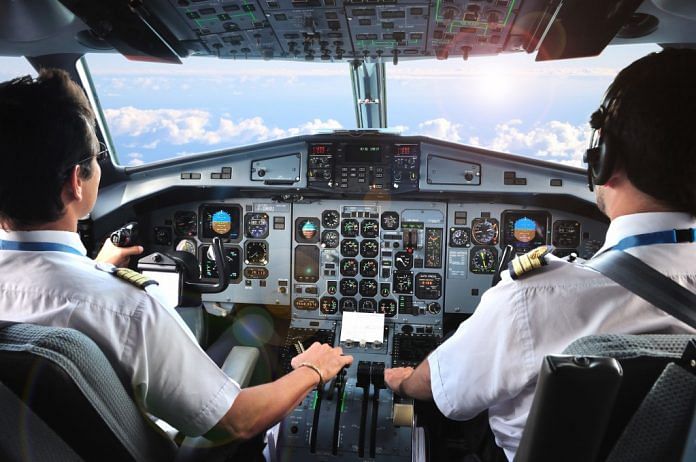Pilot and co-pilot of a flight from London to Mumbai, who were allegedly in a relationship, came to blows mid-air & left the cockpit, endangering passengers.
The pilot and the co-pilot of Jet Airways flight 9W 119 from London to Mumbai have been suspended since Tuesday, following a violent altercation in the cockpit.
But this isn’t the first disagreement between two pilots that has resulted in extreme inconvenience for passengers. On the contrary, emotional stress and aggressive behaviour displayed by air crews have put the safety of the passengers at risk on numerous occasions.
A chequered history
The Directorate General of Civil Aviation (DGCA) has conducted multiple investigations and suspended many pilots in the past for reported brawls in the sky and other behavioural misconduct – both on domestic airlines as well as international.
Indian cricketer Harbhajan Singh recently highlighted alleged racism and abuse by pilots when he tweeted at Prime Minister Narendra Modi, seeking help for his fellow passengers while on board a Jet Airways flight. According to him, the pilot allegedly abused a differently-abled man and physically assaulted a lady.
“There have been instances of violence and aggression previously too. There was a case in the early 2000s where a co-pilot had thrashed a cabin crew member. Although such cases aren’t such frequent, aberrations always exist,” a source at the DGCA said.
Pilots have also previously refused to fly after their duty hours were over, gotten into physical fights with the cabin crew at over 30,000 feet, and been accused of misconduct and sexual harassment by air hostesses, in what is appearing to be an exhaustive list of compliance related issues.
When emotions enter the cockpit
While high-pressure jobs that carry responsibility for other people’s lives are known to cause extreme levels of stress and exhaustion, external factors like the circumstances of one’s personal life, power dynamics between colleagues, workplace culture, and emotional triggers also contribute significantly to a crew member’s mental state on the job.
In the case of the latest incident on board 9W 119, the pilot and the co-pilot were allegedly in a relationship, hinting at the possibility that the fight was not just a professional one, and that it escalated due to personal issues. However, the pair did leave the flight, which had 324 passengers on board, entirely unmanned for brief periods, which is a grave violation of the rule requiring two people to be present inside the cockpit at all times.
It is for situations like these, as well as to minimise potential safety risks of passengers, that a DGCA rule prohibits pilots and crew who are related from flying together.
A former cabin crew member of a leading international airline also recounts her experience of pilots mis-channeling their stress on-board.
“There have been instances of commanders being nasty or rude with the cabin crew. But I don’t blame them, because it’s a culture that has been created, especially in Air India, where the pilots have been elevated to a status where they feel that they can be nasty. But most commanders are not like that,” she says.
How to manage crews
In the 1970s, investigators discovered that more than 70 per cent of air crashes involved human error rather than technical failures or weather-related incidents. The American aviation industry consulted with a group of renowned psychologists to develop a new kind of soft-skill training for flight crews. This was termed as the Crew Resource Management (CRM) module.
“CRM creates simulations that foster open dialogue, so everyone’s problems are a lot more relatable, humanising crew members towards each other,” explained the crew member.
A noted CRM instructor and senior captain with a leading private airline says the CRM is needed in India because of the Power Distance Index (PDI).
“It determines the amount of authority that a junior is ready to accept from a senior. In countries like America, the PDI is less, but in countries like India, Malaysia, Japan etc., the PDI is really high. This makes it difficult for juniors to speak up, because seniors used to be considered as God earlier,” he explains.
“Speaking personally as a captain of an airline, I think it is really important for the senior person to break the ice. I think it’s my duty to make the other person not feel the pressure of my command, so that he is not hesitant to tell me if something is not right,” the captain says.
“I am human, I can make errors. I need that person to be absolutely comfortable in telling me that I’m doing something wrong.”




Disconcerting and troubling. Glad there’s attempt to focus on people who fly us and land us back. Through a flight there’s little way of knowing what the pilot or his/her subordinate are doing. Perhaps they should display that too on the flight screen that tells you other information.
The United States has had a period of exceptional air safety in recent years. A commercial jet is a product of engineering excellence that leaves nothing to chance. That should not be undermined by human fallibility and deviant behaviour.